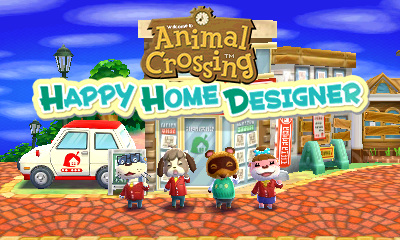 A new twist on Animal Crossing
A new twist on Animal Crossing
Ever since Animal Crossing made its debut on Nintendo GameCube some fourteen years ago, fans have been enamoured with this cute and charming life simulation franchise. Recently released on Nintendo 3DS, Animal Crossing: Happy Home Designer is the latest game in this beloved series and the very first spin-off title in its history.
So how exactly does this game differ from a traditional Animal Crossing game? Well, Happy Home Designer forgoes many of series’ traditional gameplay activities such as catching bugs, digging up fossils, and fishing, in lieu of a more compact, linear experience focusing exclusively on house design. If you’ve played 2013’s excellent Animal Crossing: New Leaf, then you can think of Happy Home Designer as a large expansion of that game’s unique interior design mechanics.
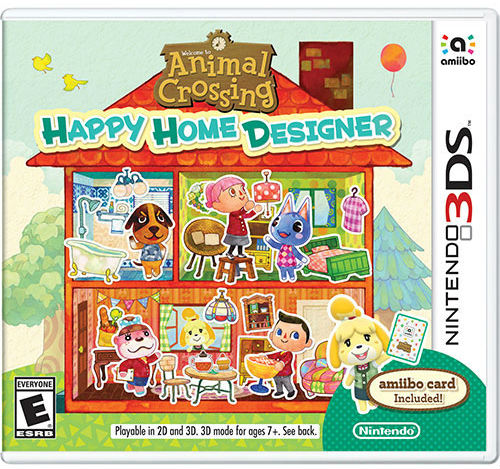
Game Details
Platform: Nintendo 3DS
Developer: Nintendo EAD Group No. 2
Publisher: Nintendo
Release Date: September 25, 2015
Genre: Home design, Simulation
Modes: Single-player
ESRB Rating: E (Everyone)
Beginning your new job
You begin Happy Home Designer as a young, plucky, jovial new hire for the Happy Home Academy, a house design firm owned by resident Animal Crossing serial entrepreneur, Tom Nook. After choosing your character’s gender, eye shape and colour, hairstyle and hair colour, and skin tone, it’s off to your first day on the job.
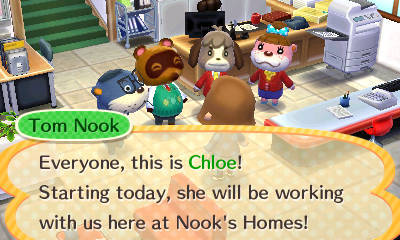 Greeting you at the door is a pair of bubbly, familiar Animal Crossing friends, Lyle the otter and Digby the dog, along with an all-new pink otter named Lottie who happens to be Lyle’s niece (you can see the whole crew in the photo to the left.) Lottie, being an eager helper, takes you under her wing on your orientation day, instructing you to put on your staff uniform before taking on your first client.
Greeting you at the door is a pair of bubbly, familiar Animal Crossing friends, Lyle the otter and Digby the dog, along with an all-new pink otter named Lottie who happens to be Lyle’s niece (you can see the whole crew in the photo to the left.) Lottie, being an eager helper, takes you under her wing on your orientation day, instructing you to put on your staff uniform before taking on your first client.
Design villagers’ dream homes
As it turns out, your first assignment is to practice interior design in a sample room that just so happens to be later revealed as Lottie’s new home (that crafty co-worker!) For all jobs, you’ll be given a general theme to guide your decorating, which in this case is “a room with a lovely atmosphere,” as well as a handful of items in boxes the commissioning character deems as must-have. You can see Lottie making her request, and her cherished boxed items, in the photo below to the right.
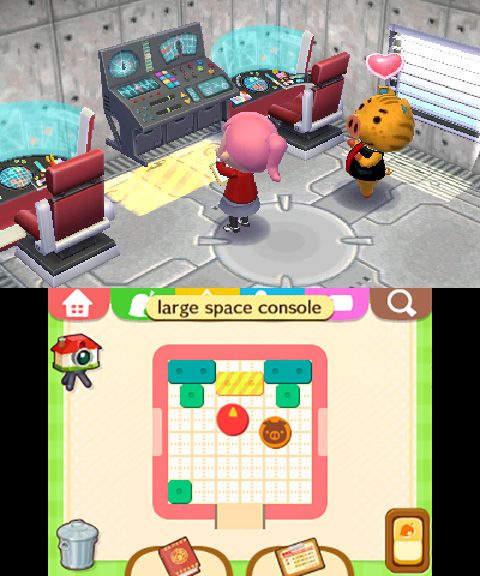
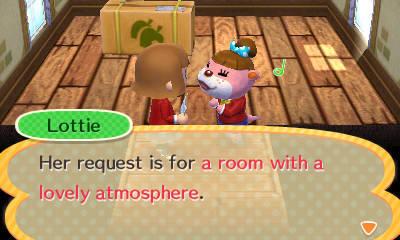
Creating room designs in Happy Home Designer is a snap thanks to the all-new grid floor planner that appears on the Nintendo 3DS’s lower touchscreen, as well as the vastly improved catalogue that groups decorations into categories and is easily searched. Inside rooms you can place all sorts of items like carpets, wall ornaments, beds, dressers, stereo systems, and many more. It’s really easy and fun to design rooms on the floor planner, since all you need to do is drag and drop items to place them, or tap them once to rotate 90 degrees. Likewise, searching your catalogue of objects is very simple given your ability to not only look up alphabetically, but also by category or even colour to match your design motif. To further help you out, all the essential items each character “must-have” in their designs will always be packaged in boxes and placed in the middle of the room, which you then tap with your stylus on the Nintendo 3DS’s touchscreen to reveal their contents.
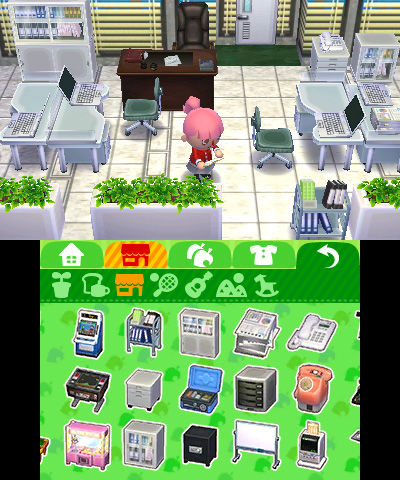 The freedom to be creative
The freedom to be creative
What I really enjoy most about Happy Home Designer is the complete freedom you have to design homes as you please, with very little restrictions to hamper your creativity. Not only is your catalogue quite vast (and it grows larger as your play), but you also have unlimited budget when making your designs. So, if you want to build a lavish Victorian-era living room complete with fancy chairs, a magnificent chandelier, and ritzy hanging art, you can; or, if you simply want to throw socks and shirts all over the floor to create a pigsty, that’s possible too. In fact, so long as you in incorporate the character’s few prized possessions into your final design, it doesn’t matter how you decorate their homes. Herein lies the greatest strength, or weakness, of this game, depending on how you look at it.
On the one hand, since Lottie, or other future characters you design homes for, do not critique the aesthetic or functional qualities of your designs, Happy Home Designer presents no real challenge to aspire to, as there’s no way to differentiate between a good or a bad design. As an example of what I mean, for my second request, a dog named Goldie asked me to design a room to resemble “a forest of books,” and gave me three mandatory items to use: a large bookshelf, a stack of books, and a phonograph. After placing the bookshelf directly in front of the main entrance, and the other two items positioned to block the sunlight coming through the side windows, Goldie still gleefully congratulated me on my superb design skills. Considering how obviously bad the room was designed, it seemed a bit silly to receive a gratifying pat on the back from my client.
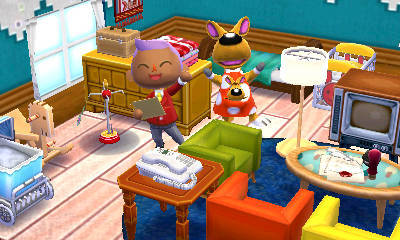 While this certainly means that Happy Home Designer isn’t a very demanding game, it’s a game that can enjoyed at a very casual, relaxing pace, perfect for its target audience of younger fans. In many ways, Happy Home Designer has more in common with artistic games like Nintendo’s Mario Paint or Art Academy series than it does with traditional Animal Crossing simulation games that place more demands and limitations on what you can do. Personally, I loved the relaxing, laid-back nature of this game, but it may not appeal to those who want a serious challenge.
While this certainly means that Happy Home Designer isn’t a very demanding game, it’s a game that can enjoyed at a very casual, relaxing pace, perfect for its target audience of younger fans. In many ways, Happy Home Designer has more in common with artistic games like Nintendo’s Mario Paint or Art Academy series than it does with traditional Animal Crossing simulation games that place more demands and limitations on what you can do. Personally, I loved the relaxing, laid-back nature of this game, but it may not appeal to those who want a serious challenge.
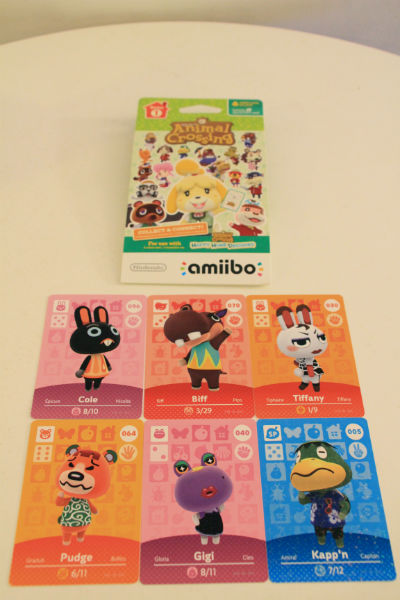 amiibo card integration
amiibo card integration
Newly introduced with the arrival of this game are Animal Crossing: Happy Home Designer Trading Cards, of which there are 100 different cards available. Each pack includes a random selection of five Animal Crossing characters plus one special character card. I’ll get into the fun ways these cards can interact with your game, but first, let me explain what you need to get started!
If you have a New Nintendo 3DS XL, you’re all set as this console includes a near-field communication (NFC) reader required to scan the Animal Crossing amiibo cards. For those with older model Nintendo 3DS systems, you’ll need to pick up the Animal Crossing: Happy Home Designer Bundle that contains the Nintendo 3DS NFC reader/writer peripheral. There’s also a New Nintendo 3DS Animal Crossing: Happy Home Designer Bundle available for those wanting to jump into the 3DS experience for the first time.
All retail versions of Happy Home Designer include one amiibo card to get you started, and you can pick up additional packs (like the one I got there on the right!) to add more Animal Crossing friends to your collection.
So what do these amiibo cards do? Well, by tapping a card to the NFC reader, the Animal Crossing character depicted on the front will appear in your game! You can invite these characters into other villagers’ homes you have decorated and have a housewarming party, or you take on design requests for the characters themselves. Some of the special characters won’t normally appear in the game and give you requests, so the only way to unlock them is by collecting their card. I had a lot of fun designing my special character’s home (it was Kapp’n the frog, seen above), and once I was finished, I invited over some of his Animal Crossing amiibo friends, like Tiffany, Pudge, and Gigi, to check out his newly decorated abode!
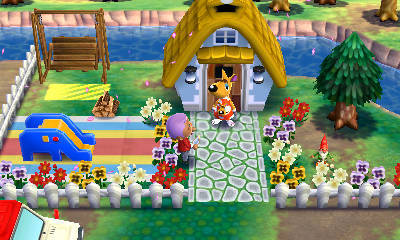 Final thoughts
Final thoughts
Animal Crossing: Happy Home Designer is a fun, charming home design game that lets you flex your creative muscle without the worry of limitations typically imposed in these types of games. Design homes exactly as you please, and watch as your village grows into a thriving town full of your favourite Animal Crossing friends. While this means the game presents little challenge, it’s refreshing to play a game that lets you play and progress as you please. When you add in the neat ways amiibo characters can interact with the game, you have a 3DS title sure to delight a younger crowd.
+ set in a cute, inviting Animal Crossing village
+ no restrictions on home designs, be as creative as you want
+ hundreds of unique objects to incorporate into your designs
+ easy to create floor plans on the touchpad screen
+ fun integration of the new amiibo cards
– virtually no challenge offered here
OVERALL
Gameplay: 4/5
Graphics: 4/5
Sound: 3.5/5
Lasting Appeal/Replayability: 3.5/5
Overall Rating 3.75/5 (75%)

By Paul Hunter, Editor Gaming
I work out of Toronto, Ontario as the Editor of Gaming here on the Plug-in Blog and as Editor-in-Chief of NextGen Player. I am thankful for having a loving and patient wife who doesn’t mind my 40 hour a week obsession with gaming. You can follow me on Twitter @NextGenPlayer




I love Animal Crossing. It was the reason I bought my Gamecube and the reason my 3DS was glued to my hip a couple summers ago. I have to admit that the home design element was always my least favourite and I thought I was in the majority until I spoke with a few others who admitted they spent hours designing their homes…go figure!
Hopefully this is the start of some good spinoffs. I wouldn’t mind seeing something more around some of the other minigames (ie. fishing/fossils) that make AC fun.
Comments are closed.